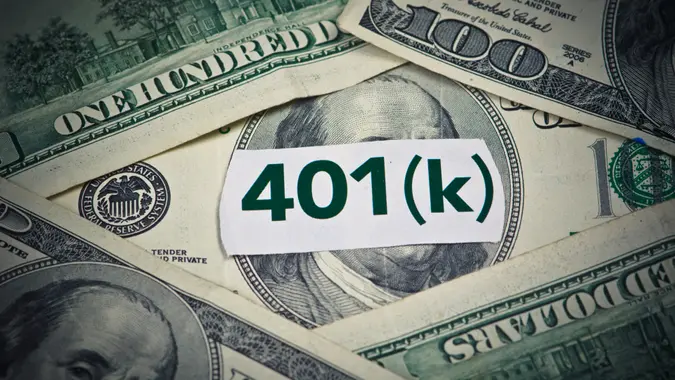What Are the Safest Investments for Your 401(k)?

Commitment to Our Readers
GOBankingRates' editorial team is committed to bringing you unbiased reviews and information. We use data-driven methodologies to evaluate financial products and services - our reviews and ratings are not influenced by advertisers. You can read more about our editorial guidelines and our products and services review methodology.

20 Years
Helping You Live Richer

Reviewed
by Experts

Trusted by
Millions of Readers
If you’re worried about losing money in your 401(k), you’re not alone. Market swings can make even seasoned investors uneasy, especially when your retirement savings are on the line.
The good news is that you don’t have to take on high risk to grow and protect your nest egg. The safest 401(k) investments are low-risk options like stable value funds, Treasury bonds and money market accounts. These choices won’t deliver explosive returns, but they can help preserve your balance and provide steady, reliable growth as you plan for retirement.
What Makes an Investment Safe in a 401(k)?
In a 401(k), safe generally means minimizing the risk of losing your money. A safer strategy focuses less on chasing high returns and more on protecting your retirement savings. Here’s what that looks like:
- Prioritize stability over big gains. Safer choices include Treasury bonds, mutual funds, and target-date funds. These investments are designed to weather market swings better than riskier options like individual stocks or volatile ETFs.
- Ideal for older or cautious investors. A conservative approach is especially valuable if you’re nearing retirement, since you won’t have as much time to recover from potential losses.
- Expect steadier, slower growth. Safe investments typically won’t deliver rapid gains, but they can provide reliable, incremental growth that helps preserve your balance for when you’ll need it most.
Top Low-Risk Investment Options in a 401(k)
If your goal is to protect your retirement savings, these low-risk investment options can provide stability and steady — though modest — returns:
Stable Value Funds
- Widely available in employer-sponsored retirement plans
- Designed to preserve your principal while delivering modest gains
- Returns typically range from 1.5% to 3.5%
- Backed by insurance contracts for added security
- Flexible–you can usually move money in or out without penalties
U.S. Treasury Bonds or Bond Funds
- Issued and fully backed by the U.S. government
- Provide fixed interest payments every six months
- Return your full principal at maturity (20 or 30 years)
- Considered extremely safe due to virtually no default risk
- Interest is exempt from state and local taxes
Money Market Funds
- Invest in high-quality debt instruments such as CDs, Treasury bills, and repurchase agreements
- Aim to preserve your capital while providing modest growth
- Typically offer higher returns than high-yield savings accounts
- Generate income through daily interest accrual
- Highly liquid and generally less volatile than stock investments
Short-Term Bond Funds
- Invest in debt securities with maturities of one to three years
- Typically offer higher yields than money market accounts
- Often come with lower expense ratios compared to other funds
- Carry less interest rate risk than long-term bonds
- Best to choose funds with higher credit quality for added safety
Target-Date Funds (Conservative Glide Path)
- All-in-one investment option with a diversified mix of assets
- Automatically reallocates to safer investments as you approach retirement
- Provides a more hands-off, low-maintenance investing approach
- Helps reduce emotional, reaction-based decisions during market swings
- Lowers the risk of significant losses near retirement
- Ideal for “set-it-and-forget-it” investors who want simplicity and balance
High-Quality Corporate Bond Funds
- Focus on investment-grade bonds issued by financially stable companies
- Offer higher returns than government bonds, though with slightly more risk
- Best to choose funds with low fees to maximize returns
- Short- to intermediate-term funds reduce interest rate risk compared to long-term bond volatility
Where Is the Safest Place to Put My Retirement Money?
As you approach retirement, you want to continue to grow what you’ve built and still take some moderate risk. Ideally you want a mixture of U.S. Treasury bonds, money market funds, stable value funds, CDs and high-yield savings accounts.
These options won’t necessarily demonstrate explosive growth, but they will protect your savings. This is effective for people who are within 5 – 10 years of retirement.
As you approach retirement, the safest place to put your money is in investments that protect your principal while still offering modest growth. A balanced approach might include U.S. Treasury bonds, money market funds, stable value funds, CDs, and high-yield savings accounts. These options won’t deliver explosive gains, but they can safeguard what you’ve worked hard to build.
This strategy is beneficial if you’re within five to ten years of retirement and want to reduce risk while maintaining steady growth in your savings.
Are Stocks Safe for 401(k) Investments?
Stocks can absolutely play a role in a safe 401(k) strategy — it just depends on how you invest. Choosing dividend-paying stocks from established companies like Johnson & Johnson, Procter & Gamble, or PepsiCo can provide both stability and regular income. Another option is blue-chip stocks, which represent well-established companies with a history of steady performance and generally less volatility than smaller firms.
That said, stocks naturally come with more ups and downs. While they offer greater potential for long-term growth, they also expose you to short-term risk. The safest approach is usually a balanced one–mixing stocks with bonds and other lower-risk investments to keep your portfolio both resilient and growth-oriented.
FAQ
- What Is the Safest Investment in a 401(k)?
- Some of the safest options include money market funds, short-term Treasury funds, and stable value funds. These choices prioritize preserving your principal while still offering modest, steady growth.
- Are Treasury Bonds Good for Retirement Savings?
- Yes. Treasury bonds are backed by the U.S. government, making them one of the most reliable investments for retirement. They provide predictable interest payments, help stabilize your portfolio, and act as a buffer against market volatility.
- How Do I Make My 401(k) Less Risky?
- The best way is through diversification—spreading your money across different types of investments rather than concentrating in a single sector or stock. Shifting some funds into safer options like money market funds, bonds, or a target-date fund can also lower your risk, especially as you get closer to retirement.
- Can I Lose Money in a 401(k) Even With Safe Investments?
- Yes. While safe investments reduce risk, they’re not entirely risk-free. Factors like inflation, management fees, interest rate changes, and market downturns can still erode returns or reduce your account balance over time.
 Written by
Written by  Edited by
Edited by 

























